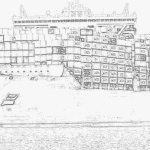The good poets are people who are at the finest point of awareness of an age. They are more aware than any other people. Their consciousness is like a fine gossamer in which the smallest particle of dust also causes a vibration and significance. lt is in such vibrations that they catch the strange and irregular rhythm of life. The comparative shortness of a poem is not a paper-saving device of a writer and neither are the poets such persons who have no time to write a novel or a drarna. There is no need for writing in verse what can be communicated in good prose. Just as reason is the province of prose, imagination is the priviledge of poetry. The test of a good poem is that it stands different types of interpretations and still the meaning remains tentative and indeterminate. Symbol and metaphor take over where the rational word order fails to communicate but they are very much in use in common speech of day to day conversation. The language of poetry has to be racy and expressive but it need not necessarily be difficult to the point of opacity. Good poetry can communicate to the readers before it is understood. A good poem, perhaps the best words in the best order, has an adhesive quality of its own to stick to the reader’s memory.
[amazon_link asins=’9351381897′ template=’ProductAd’ store=’ir027-21′ marketplace=’IN’ link_id=’7ade4f42-fb6f-11e6-a935-c7b1e689fb98′]
R L. Rosenthal, an important critic of poetry, states in the preface to Poetry and Common Life that there has been an attempt in recent times to deprive common people of poetry on the pretext that they do not understand poetry. He does not mean that a poem should be transparent and that there is no pleasure in puzzling out the meaning of a poem after repeated readings, but he believes that with apparently simple words and collocations also a poet can explore profound and unresolved problems of life. Poetry need not be over- intellectualised.
Assamese poetry influenced by Mallarme, Baudalaire, Paul Valery, Eliot and the like is often found unintelligible by average readers. The so called revolutionary poems of protest also often boil down to political dogmas stated in verse. As a result, the readership fell. The reaction of the readers also cannot always be a safe and reliable index of the achievements of the poets as the cultural life of the former may sometimes be exposed to different influences to the point of being porous to affect their literary tastes and sense of discrimination. But the fact also remains that there must be a readership. Contemporary Assamese poetry, in this regard, offers a scene that brightens our hope. Small magazines may not be all gold, but neither are they all trash. In any literature in a given time, the house is always full even without the new writers. The new writers resort to different methods to invite attention. They knock hard at the door apparently to smash it but they hope that the door will be opened and they will be accommodated. They want to break away from the tradition and assert their novelty. The tone of anger, rebellion and protest is more pronounced in the little magazines. Regular magazines published monthly or fortnightly cannot give much space to poetry and they play safe by publishing poems of a handful of poets already familiar with the reading public. lt is the small magazine that usually brings a new poet to the limelight. Most of the poets, how familiar to the readers, made their debut in some little magazines.
There has been an attempt among the contemporary Assamese poets writing mostly in the little magazines to bring poetry close to the rhythm of the rural life. Their language, accordingly, is the language of the common people. The images and metaphors are also taken from life in the countryside. This phenomenon bears close resemblance to the reaction of the English poets like Cawper, Gray, Chatterton etc. against the over refinement of Alexander Pope. Rural life is very much present in the poetry of the established poets like Nabakanta Barua, Nilmoni Phukan, Hiren Bhattacharyya etc., but with some of the young contemporary poets rural life becomes synonymous with poetry. Many others read different meanings into the landscape of the countryside.
Ram Gogoi, the poet. of the paddy field, visualises a society free from exploitation and injustice and his vision of the happy society is concretised in the form of a paddy field of golden corn. Ram Goswami, a well·known poet, writes on Himalayan hope amidst torment and suffering : “Pests in the paddy field/The field builds the bridge of sigh anew/On the shameful road, winding through wicked Anandas/ln a silvery afternoon corn is fragrant, a soothing breeze in my heart.” Fragments of country-life have been the subject matter of many poets. Ms Anupama Basumotary writes : “A slice of sweet and fresh pineapple or a mango green/Bite with a chuckle to pass off a fickle noon.This snapshot records a rhythm that pulsates rural life in Assam. The poet is not trying to rediscover the rhythm of modern life in the countryside, but the evocation rings true to the readers. Ms. Archana Puzari draws with remarkable economy how dreams are cherished in the poor countryside in the form of rearing up a brood. This dream is central to all creative work, it is the directing spirit. Ms Archana Puzari gives a welcoming cry to the dream of a flight of the fledgeling: “Break open the egg shell/Welcome ye flight/ Feed a morsel, tie up a dream to the wings/Be a pilgrim of the sky.” Bird rearing, hatching eggs, feeding birds etc. are a common sight in the countryside and the dream is a metaphor extended from the common sight. The person who is a keeper of the brood is also the dreamer of the dream. Finally, the brood itself is an objectification of a dream. Dhruba Kumar Talukdar tells of a dream that does not materialize and uses brooding as a metaphor to convey that reality of the dream that shatters: “Inside a rotten egg, you keep brooding over our dream.” The picture is that of political demagogues cheating the masses by creating illusions in them. Rajib Barma fuses wit and indignance into a fragmented picture of rural masses sweating their blood out in daily drudgery and utter disappointment that they often meet with : “They sweat their blood out/ Dead by half taking pesticides for vermins/Children’s play stop halfway as light fails … ” Ms. Anupama Dutta Saikia‘s “A Love Poem”, while talking about the fullness of life in an unconscious moment, depicts the abiding relationship between man and the tree : “Eyes open and my eyes shut, I feel the tree/From morning till night in every pore of my skin.”
A shower can regenerate dying nature. Lakshya Kumar Handique adds another attribute to this shower—it can restore lost creativity to life : “A shower will harrow/The hard and dry clods of sorrow.” The image is picked up from the field. The peasants know well how difficult it is to break the hard and dry clods to prepare the soil for crops. A picture of the mother-son relationship in the countryside has been aptly epitomized by Ms. Ellie Ahmed in feeding frugal meals : “Where are the faces now/ My children who wiped their mouths with me torn fringe of my chadar/Having eaten stale watered rice with just chilli and onion.” The abiding relationship between the farmer and the paddy field transforms into a tidy image in a poem by Ms. Biva Das : “I touched the stalk of rice/It giggled at once.” The farmers all throughout the ages have shared the joy of the field that teems with life and activities. The farmer may not always find verbal equivalent of his feelings at the touch of the stalk, but he feels it. Ms. Sanchita Bora delightfully describes the emotional attachment of the cowherd boy to his cow and the calf .The relationship is truth of rural life. To quote Ms Bora: “Your black heifer gets pregnant in your dream./ At the sight of the month-old calf/You throw away the stick in hand” Instead of ruling the cow, the cowherd yields to the love of the cow and the calf.
A moonlit night, though familiar to one and all, ever remains an inexhaustible source of happiness for men, and especially, in the countryside. Biren Hazarika writes : “From a silver pitcher/The full moon pours forth thc wine of light/Silvery intoxication shines a twink1e.” Prema Gogoi, a poet in his own right, talks about hypocrisy, tyranny and frand of the social system and brings out the resulting pathos, by setting in sharp contrast, the decay of values with thefullness of life represented by the rice field : “Ye earth l much have I traveled wading through slush/The sprout of hope was not transplanted/No use sharpening the sickle _now in search of a golden harvest/The sad lips have lost all morning songs.”
A remarkable young poet of the paddy field is Cheniram Gogoi. The paddy field and the wide expanse of the countryside are not a backdrop to his poems but the poems themselves. He is keenly aware of the realities of rural life. He, like many of his contemporaries has been trying to weave the spirit of the age into the verbal structures, but in doing so, the images, metaphors and symbols are drawn mostly from rural life. The surface simplicity of his poems is deceptively delightful and it often hides many shades of meaning. To quote Mr Gogoi : “Many a fish once died of disease/Yet no river died of grief/Animal families moved far off/The desertion did not kill the tree.” The relationship between fish and rivers and animals and trees, as perceived by the poet, is original and they reflect a definite attitude of the poet towards life and the world. Death of fish is a tragic loss but it cannot interrupt the flowing of the river. Likewise, the tree continues to live even when its friendship and rapport with the animal family snaps due to the migration of the latter. Death, desertion, disease, loneliness and heartbreak cannot alter the course of eternal life. Kaustubhmoni Saikia has intimate understanding of the countryside in all its distinctive features. His poems are simple and delightful. He loves the landscape as much as he loves the masses. He feels the suffering of the toiling masses and at the same time celebrates the freedom and creativity of the field.
Critics and readers of modern poetry once complained that the poets far outnumbered the readers. It was primarily because of difficulty of modern poetry. The trend in contemporary Assamese poetry and especially, in the poetry of the beginners, is to keep close to the rhythm of rural life. Systematic study alone can decide if it is a kind of neo-romanticism. A poet, in order to be at the finest point of awareness of an age, cannot divide life as urban and rural and dwell on one to the exclusion of the other. ·But so far as the poets draw images and symbols from rural landscape familiar to the readers, poetry offers delight.
Dr. Ananda Bormudoi teaches English in Dibrugarh University. He is a writer and a critic.







Leave a Reply